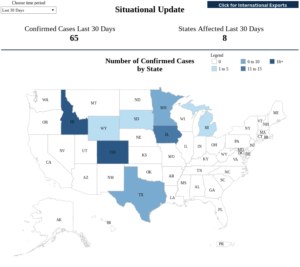As the holidays approach, bird flu is once again sweeping through commercial and backyard poultry flocks, infecting and killing more than 8.9 million turkeys, chickens, and ducks in the U.S…
USDA to Pay Dairies For Milk Loss Due to Bird Flu
Progressive Farmer’s Chris Clayton reported Thursday that “USDA will now pay dairy farmers for lost milk production if their herds have been infected with H5N1 highly pathogenic avian influenza.”
“Starting Monday, July 1, producers who have confirmed infections in their herds can apply for lost milk production at the Farm Service Agency under the Emergency Assistance for Livestock, Honeybees, and Farm-raised Fish Program (ELAP),” Clayton reported. “The program will pay those dairy farmers up to 90% of milk-production losses for farms infected in the H5N1 outbreak.”
“To apply and receive payments, producers must show that their herds have confirmed positive tests through USDA’s Animal and Plant Health Inspection Service (APHIS) National Veterinary Services Laboratories (NVSL),” Clayton reported. “In calculating the ELAP payments, the per-cow milk loss will be determined based on an expected 21-day period of no milk production when a cow is removed from the milking herd, followed by seven days when the cow has returned to milking but produces 50% of the normal amount of production, USDA stated.”
Current State of the Bird Flu Outbreak
Reuters’ Leah Douglas reported Thursday that “bird flu has infected 132 dairy herds in 12 states since March.” Clayton reported that “one-third of those herd outbreaks have been confirmed in just the past three weeks. On June 7, USDA reported 86 dairies had been infected.”
The state with the largest amount of dairy herds affected by bird flu in the United States is Colorado (18 herds), followed by Idaho (17 herds) and Iowa (11 herds), according to the USDA’s Animal and Plant Health Inspection Service. All identified cases since June 21 have been located in Colorado and Iowa.

Compensation Only For Milk Loss
Agri-Pulse’s Steve Davies reported Thursday that Ag Secretary Tom “Vilsack said at this point, USDA was not providing compensation for culled cows but added, ‘We’re comfortable with the level of assistance that we’re providing. We’re providing additional resources for farmers to do enhanced biosecurity planning, we’re providing assistance to offset veterinarian services for dealing with sick cows and we’re providing additional money for testing.'”
“Reimbursement is available, as well, for sending samples for testing and for personal protective equipment being used by farmers and dairy farm workers,” Davies reported. “‘I think we are really stepping up in a way that is most effective and most responsive to the impacts of this disease,’ he said.”
Dairy Market Remains Mostly Unaffected
Davies reported Thursday that “Vilsack said the loss of milk production has so far not affected the market, noting that the infected herds so far represent a small fraction of the approximately 24,000 herds in the U.S.”
“He added that six states have now joined a voluntary herd status pilot program ‘designed to give dairy producers more options is to monitor the health of their herds and to move cows more quickly, while providing ongoing testing and expanding our knowledge and understanding of this disease,'” Davies reported. “Those states are North Carolina, Ohio, New Mexico, Nebraska, Kansas and Texas.”
“The pilot program ‘is going to provide us additional opportunities to test herds that are not known to be infected with the virus, which will improve our surveillance and continue to expand our knowledge of this disease,’ Vilsack said,” according to Davies’ reporting.





